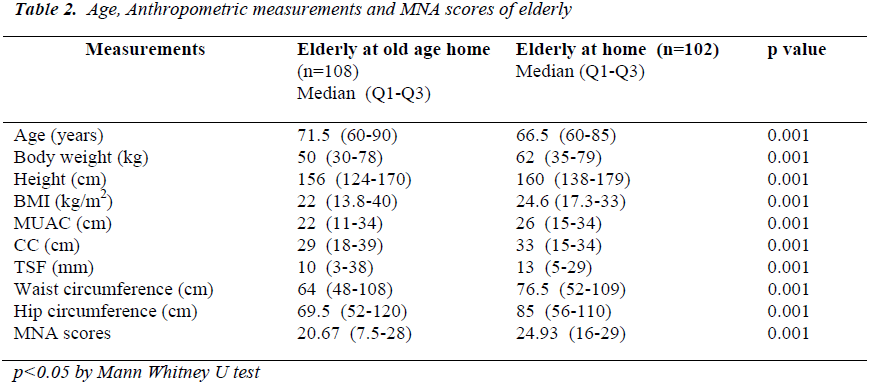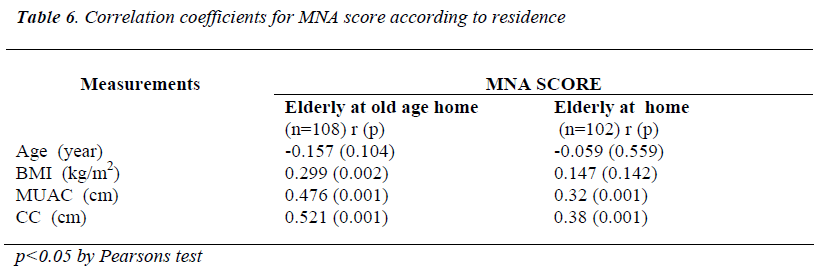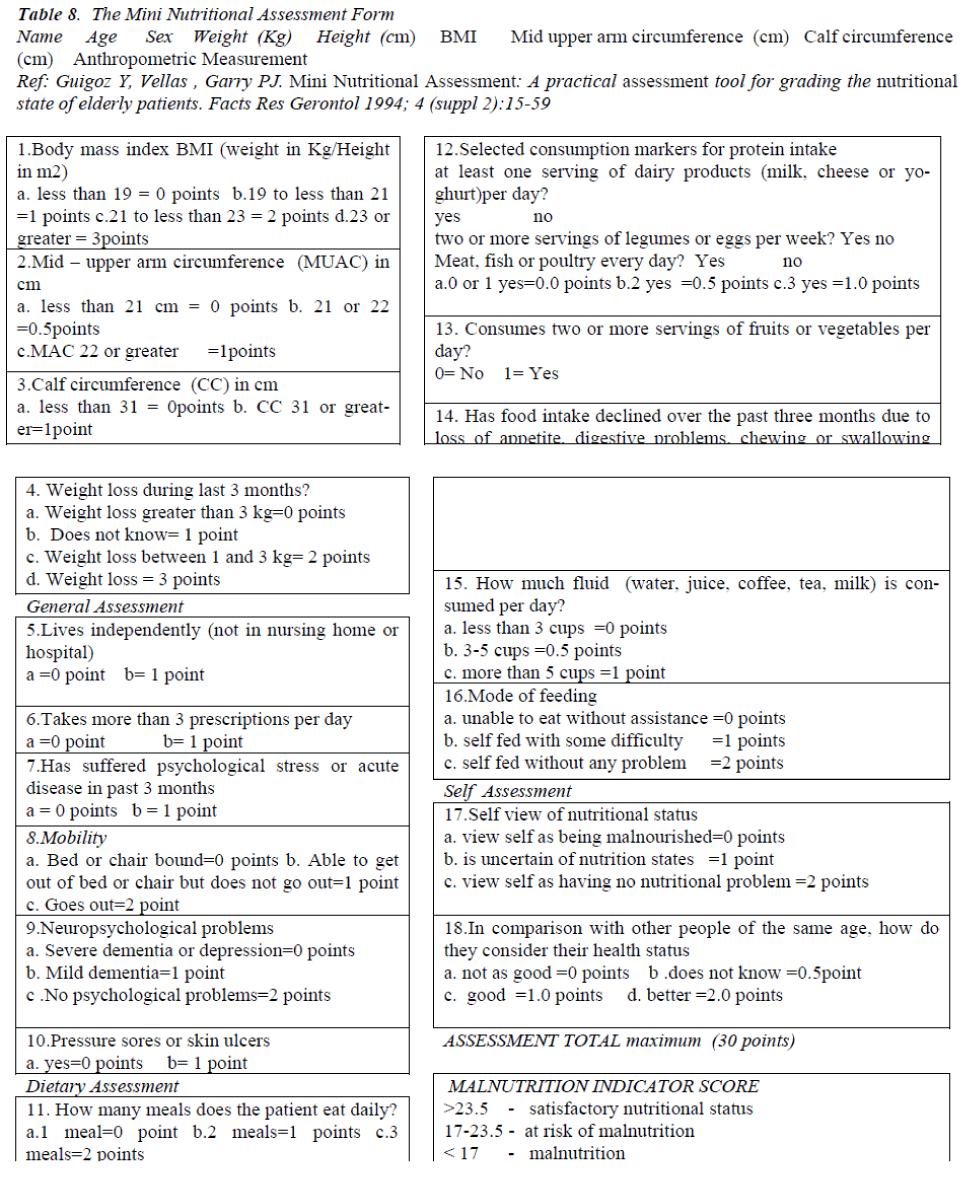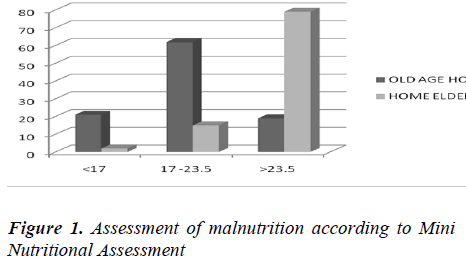ISSN: 0970-938X (Print) | 0976-1683 (Electronic)
Biomedical Research
An International Journal of Medical Sciences
- Biomedical Research (2011) Volume 22, Issue 1
Comparative study of nutritional status of elderly population living in the home for aged vs those living in the community
Department of Physiology, Kasturba Medical College, Manipal, India
- *Corresponding Author:
- Kirtana M Pai
Department of Physiology
Kasturba Medical College
Manipal-576 104, India
Accepted date: August 27 2010
The higher incidence of malnutrition in elderly is well documented. Elderly nursing home residents seem to have a higher risk of malnutrition with respect to the community dwell-ing elderly population. A comparative study was therefore performed to evaluate the nutri-tional status of elderly living at old age homes and in community, in the city of Mangalore. Subjects aged over 60 years were included in this study. Nutritional status was evaluated by anthropometric measurements to calculate the Body Mass Index, W/H ratio, and Tri-ceps skin fold thickness and by data collected through the Mini Nutritional Assessment. A total of two hundred and ten subjects participated in this study. The study subjects were constituted by 108 inmates of old age homes and 102 people who were residing at their houses. The results showed that the elderly at home had higher BMI (p<0.001) and higher MNA scores (p<0.001) compared to those living in old age homes. The MNA results re-vealed that 19.4% of subjects were malnourished and 57.4% were at risk of malnutrition among the old age home residents. The prevalence of malnutrition by MNA was 2%, those at risk of malnutrition were 14.7% in free living elderly. The results of this study show a high risk of malnutrition (p<0.05) in the old age home residents, and confirm the need for increased surveillance of nutritional status among residents of old age homes.
Keywords
Elderly, malnutrition, anthropometric measurements, Mini Nutritional Assessment
Introduction
India has acquired the label of aging nation with 7.7% of its population being more than 60 years old .There has been a sharp increase in the proportion of elderly popula-tion in India as a result of demographic transition [1]. The proportion of elderly persons in the population of India rose from 5.63 per cent in 1961 to 6.58 per cent in 1991[2] and to 7.5 per cent in 2001and it has been esti-mated that they would become 12% of total population by 2030[3].This is attributed to decrease in mortality arising from longer lifespan of individuals and improvements in public health and medical services leading to control of infectious diseases. The rapidly increasing aging popula-tion adds to the socio economic challenges that face India [2,3]. The scientific progress has reached a level where nutritional interventions may play a part in the prevention of degenerative conditions of age, improvement of quality of life and impact on health care burden and resources. Moreover a timely intervention can stop weight loss in elderly at risk of malnutrition or undernourished [4].Evaluation of nutritional status is important for any nutrition or dietary modification. We therefore did a com-parative study to evaluate the nutritional status of elderly living at old age homes and in community, in the city of Mangalore combining anthropometry and mini nutritional assessment. Nutrition screening of older adults is ex-tremely difficult; the shortcomings of existing screening tools do not make the problem any easier [5].Some of the screening methods can only be administered by trained clinicians. Biochemical markers are time consuming and expensive to use in home situations, and the criteria for their interpretation in old age are unclear [6].A compre-hensive tool specifically developed for use with elderly people is the Mini-Nutritional Assessment (MNA): this is a rapid and simple tool for evaluating the nutritional state of the frail elderly, which allows, if necessary, for nutri-tional intervention and/or diet modification[7].The MNA is a test composed of 18 simple and rapid easy to measure items which can be performed in less than 15 minutes. (Table 8)[8]. The MNA has been validated in three suc-cessive studies of more than 600 elderly [7]. The MNA detects risk of malnutrition before severe change in weight or serum proteins occur [4].
Materials and Methods
A total of 210 subjects above 60 years of age were studied over a period of 30 days. As it was a time bound study, those elderly subjects available during the limited time period were included. The study subjects were constituted by 108 inmates of old age homes and 102 people who were residing at their houses. The standard informed con-sent was taken from all the subjects following approval from the college ethics committee. The old age home in-mates were studied from Abhaya Ashram at Kodialbail, Prashanti Nivas Jeppu, Geriatric ward of Kasturba Medi-cal College, Mangalore. The members of KMC Ashraya were also included in this study. KMC Ashraya is an or-ganization within KMC, working for the welfare of senior citizens, and physically disabled.
Inclusion criteria
Subjects over 60 years of age were included in this study as this is the geriatric age group as defined by the World Health Organisation.
Exclusion criteria
Subjects with cancer, end-stage renal disease or terminal illness.
Those receiving artificial enteral or parentral nutrition.
A detailed history was taken and clinical examination was done for each subject.
Persons with chronic illness (diabetes, hypertension, COPD) were categorized into the co-morbidity group. Every subject under study was individually assessed for nutritional status with anthropometry and Mini nutritional assessment.
Anthropometry
Height, weight, mid upper arm circumference (MUAC), calf circumference (CC) and triceps skin fold thickness (TSF) of all subjects were measured by standard tech-niques. Lange calipers were used to measure triceps skin fold thickness. Body mass index (BMI) of all subjects were calculated. Waist and hip circumferences were also measured and W/H ratio calculated.
Waist-Hip ratio >1.0 in men and >0.85 in women have a greater risk of stroke, coronary artery disease and diabetes mellitus [9].Accordingly the W/H ratio of the elderly sub-jects were divided into normal or at risk groups. Mini nutritional assessment-
The test involves (1) anthropometric assessment (weight, height, mid arm and calf circumferences, weight loss) (2) general assessment (six questions related to lifestyle, medication and mobility) (3)dietary assessment (eight questions related to number of meals, food and fluid in-take, and autonomy of feeding); and (4) subjective as-sessment (self perception of health and nutrition). The test did not require any modification to be applied in the study population. A score was given to each subject on the basis of MNA questionnaire. The scoring categorizes the eld-erly subjects in the following manner.
>23.5 - satisfactory nutritional status
17-23.5- at risk of malnutrition
< 17 -malnutrition
Gender, categories of MNA score and W/H ratio were summarized using frequency and percentage across the elderly at old age home and at home. Chi Square test was used to compare the differences in nutritional status be-tween two groups and to find the association between nutritional status and co morbid illness at old age home and home separately. Age, Height, Weight, BMI, Mid upper arm circumference, Calf circumference, Triceps skin fold thickness, Waist and Hip circumferences, and MNA scores were summarized using median and Inter-quartile range across the two elderly groups. Mann Whit-ney U test was used to compare the median differences between the two groups. Pearsons correlation coefficients were performed for linear relations between total MNA scores and BMI, MUAC, CC and age.
The data were analysed using SPSS for windows version 15 (Bangalore). A p value of less than 0.05 was consid-ered to be statistically significant.
Results
Out of the total 210 elderly population studied, 108 sub-jects were inmates of old age home and 102 subjects were residing at their houses. Table 1 shows the distribution of elderly subjects according to residence and gender. The age and anthropometric measurements of the subjects according to the residence are depicted in Table 2. The mean MNA scores of the subjects were higher in the sub-jects at home compared to those in old age homes (p<0.001). The prevalence of malnutrition was 2.0% in the free living elderly and 19.4% in old age home resi-dents (by MNA) (Table 3).Age wise prevalence of mal-nutrition is shown in Table 4. Table 5 gives the distribu-tion of elderly subjects according to co morbid illness. There was no significant difference between at risk, mal-nourished and well-nourished groups (p=0.397 at old age home, p=0.197 at home). Total MNA scores positively correlated with mid upper arm circum-ference both in old age home residents (r=0.472,p=0.001) and in residents at home. (r=0.32,p=0.001).There was significant positive correlation between MNA scores and calf circumference in both the groups (r=0.521,p<0.001 in old age home subjects, r=0.38,p<0.001 in subjects at home).With BMI there was significant correlation only with elderly at old age home (r=0.299,p<0.002).There was no correlation of MNA scores with age. (Table 6).The waist hip ratio was at risk in 47% of subjects in old age home and 60% in elderly at home. The difference was statistically different (p<0.027) (Table 7).
Discussion
In the present study the prevalence of malnutrition was 2.0% in the free living elderly and 19.4% in old age home residents (by MNA) (table 3).The prevalence of malnutri-tion in free living elderly is similar to that found by Soini et al [10] but less than in Maliheh et al[11]. In old age home residents, the number of people who were malnour-ished is less than in Souminen et al [12] more than Lan-giano et al [13]. According to MNA, those at risk of malnutrition were 57.4% in old age home residents and 14.7% in free living elderly subjects. Thus 76.8% subjects in old age home were either malnourished or were at risk of malnutrition. Even without an acute or chronic disease, the composition of body changes with age [14].Loss of muscle mass starts in the middle of adulthood and contin-ues through old age. A dietary nutrient deficit with lower energy expenditure is associated with decreased weight and height in the elderly [15,16].The decreased height in elderly is also result of shortening of spinal column with associated osteoporosis and kyphosis [17]. The nutritional status is independent of associated co morbid illness (ta-ble 5).So aging perse with decreased nutrient intake and lack of exercise would have resulted in lower BMI (table 2) and increased risk of malnutrition in elderly at old age home.
The MNA score showed significant correlation with mid upper arm circumference and calf circumference in both the groups. With BMI, there was significant correlation only in nursing home residents (table 6). Thomas et al had found high correlation of MNA score only with BMI [18].However with age, there was no correlation with MNA score. Anja Saletti et al showed that age correlated with MNA score and BMI [19]. A study on 1564 elderly volunteers in Turkey showed a decrease in MNA score with increase in age [20].
The significant difference between the triceps skin fold thickness of the two groups might indicate towards lesser nutritional status in old age home residents (table 2). The mean value of waist circumference in free living elderly and old age home residents was 78.5 and 66.1 respec-tively (table 2).The difference was statistically very highly significant. The waist –hip ratio of elderly at home were more at risk compared to old age home residents (table 7).This may predispose the elderly at home for trunkal development of metabolic syndromes. Sibai et al showed that elderly living at home had significantly higher waist circumference and mean body mass index than those living in institutions [21]. Prospective studies of Gotherburg, Sweden have shown that both men and women who have a high Waist-Hip ratio have increased risk of death, stroke, IHD, Diabetes mellitus, Hyperten-sion and Hyperlipidemia [22].According to Gill et al Waist Hip Ratio was positively related to circulatory mor-tality in both men and women [23].
Conclusion
1. Undernutrition as well as obesity are common health hazards in our geriatric population.
2. The prevalence of malnutrition (by MNA) is sig-nificantly higher in inmates of old age home com-pared to elderly at home.
3. Mini Nutritional Assessment appears to be a prac-tical and reliable method to assess the nutritional status of elderly people and more importance should be attached to those living in old age / nurs-ing homes to prevent their nutritional problems.
4. The elderly at home are posed at greater risk of health problems resulting from obesity.
Acknowledgements
I sincerely thank Mr Vasudeva Gudattu, Lecturer in De-partment of Biostatistics, Manipal University for his valu-able guidance.
References
- Irudaya RS. Demography of ageing. In: Dey AB, edi- tor. Ageing in India, Situational analysis and planning for the future. New Delhi: Rakmo Press; 2003.
- Mishra US, Irudaya RS, and Sarma PS. eds. India’s Elderly: Burden Or Challenge? New Delhi: Sage Publi- cations and London: Thousand Oaks, 1999.
- Irudaya RS, Sarma PS, Mishra US. Foundation of Ag- ing In India In: Liebig P, Irudaya R.S., eds. An Aging India: perspectives, prospects and policies, Haworth Press; 2003.
- Guigoz Y. The Mini Nutritional Assessment (MNA) review of the literature--What does it tell us? Journal Nutr Health Aging 2006; 10 (6):466-85.
- Schneider SM & Hebuterne X. Use of nutritional scores to predict clinical outcomes in chronic diseases. Nutr. Rev 2000; 58: 31-38.
- Reuben DB, Greendale GA, Harrison GG. Nutrition screening in older persons. J. Am. Geriat. Soc. 1995; 43: 415-425.
- Guigoz Y, Vellas B, Garry PJ. Mini Nutritional As- sessment: A practical assessment tool for grading the nutritional state of elderly patients. Facts Res Gerontol 1994; 4 (suppl 2): 15-59.
- Gugoiz Y, Vellas B, Garry PJ. Assessing the Nutri- tional state of the Elderly: The Mini Nutritional As- sessment as part of the Geriatric Evaluation. Nutritional Reviews 1996; 54 (1): 59-65.
- Baron RB. Nutrition: In: Current Medical Diagnosis and Treatment. 45th Ed McGraw-Hill; USA 2006; pp 1267.
- Soini H, Routasalo P, Lagstrom H. Characteristics of the Mini-Nutritional Assessment in elderly home-care patients. European Journal of Clinical Nutrition 2004; 58: 64-70.
- Aliabadi M, Kimiagar M , Ghayour-Mobarhan M , Shakeri MT, Nematy M, Ilaty AA, Moosavi A.-R, Lanham-New S. Prevalence of malnutrition in free liv- ing elderly people in Iran: a cross-sectional study. Asia Pac J Clin Nutr 2008; 17 (2):285-289.
- Suominen.M., Muurinen S, Routasalo P, Soini H, Suur- Uski I, Peiponen A, Finne-Soveri H, Pitkala KH. Mal- nutrition and associated factors among aged residents in all nursing homes in Helsinki. European Journal of Clinical Nutrition 2005; 59: 578-583.
- Langiano E, Di Russo C, Atrei P, Ferrara M, Allegretti V, Verdicchio I, De Vito E. Nutritional status of elderly institutionalized subjects in a health district in Frosi- none (Italy). Ig Sanita Pubb. Jan-Feb; 2009; 65 (1):17- 28.
- Kehayias JJ. Aging and Body Composition. In: Rosenberg IH, Ssatre A, editors .Nutrition and Aging. Nestle Nutrition Workshop Series Clinical and Performance Programme, Volume 6, Basel:S Karger AG;2002, pp 63-78.
- Elia M. Obesity in the elderly. Obes Res 2001; 9: 244- 248.
- Santos JL, Albabla C, Lera L, Garcia C, Arryo P, Perez Bravo F. Anthropometric measurements in the elderly population of Santiago Chile. Nutrition 2004; 20: 452-457.
- Lewis JE, Bell SJ. Nutritional Assessment of the Eld- erly. In: Morley JE, Glick Z, Rubenstein LZ, editors, Geriatric Nutrition a Comprehensive Review, NewY- ork: Raven Press;1990, pp73-87.
- Thomas DR, Zdrowski CD, Wilson M.-M, Conright KC, Lewis C, Tariq S, Morley JE. Malnutrition in subacute care. American Journal of Clinical Nutrition February 2002; 75 (2): 308-313.
- Saletti A, Lindgren EY, Johansson L, Cederholm T. Nutritional Status According to Mini Nutritional As- sessment in an Institutionalized Elderly Population in Sweden. Gerontology 2000; 46 (3):139-145.
- Kucukerdonmez O, Koksal E, Rakicioglu N, Pekcan G. Assessment and evaluation of the nutritional status of the elderly using 2 different instruments. Saudi Med- ical Journal Oct 2005 26 (10): 1611-1616.
- Sibai A.-M., Zard C, Adra N, Baydoun M, Hwalla (Baba) N. Variations in nutritional status of elderly men and women according to place of residence. Ger- ontology 2003; 49 (4): 215-224.
- Bray G.A. Pathophysiology of obesity. Am. J Clin Nutr. 1992; 55: 488-945.
- Price G.M., Uavy R, Breeze E, Bulpitt CJ, Flether A.E. Weight, shape, and mortality risk in older persons: elevated waist-hip ratio, not high body mass index, is as- sociated with a greater risk of death. Am. J. Clin. Nutr. Aug 2006; 84 (2): 449-460.








